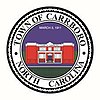Venable, North Carolina
| Town of Carrboro, North Carolina | ||
|---|---|---|
| Town | ||

The Carrboro Farmers' Market
|
||
|
||
| Nickname(s): The Paris of the Piedmont | ||
 Location of Carrboro, North Carolina. |
||
| Coordinates: 35°55′14″N 79°5′2″W / 35.92056°N 79.08389°WCoordinates: 35°55′14″N 79°5′2″W / 35.92056°N 79.08389°W | ||
| Country | United States | |
| State | North Carolina | |
| County | Orange | |
| Settled | 1882 | |
| Incorporated | 1911 | |
| Named for | Julian Shakespeare Carr | |
| Government | ||
| • Type | council-manager | |
| • Mayor | Lydia Lavelle | |
| Area | ||
| • Total | 6.5 sq mi (16.8 km2) | |
| • Land | 6.4 sq mi (16.7 km2) | |
| • Water | 0.03 sq mi (0.08 km2) | |
| Elevation | 460 ft (256 m) | |
| Population (2010) | ||
| • Total | 19,582 | |
| • Density | 3,000/sq mi (1,200/km2) | |
| Time zone | EST (UTC-5) | |
| • Summer (DST) | EDT (UTC-4) | |
| ZIP code | 27510 | |
| Area code(s) | 919 | |
| FIPS code | 37-10620 | |
| GNIS feature ID | 1019538 | |
| Website | townofcarrboro.org | |
Carrboro is a town in Orange County in the U.S. state of North Carolina. The population was 19,582 at the 2010 census. The town, which is part of the Raleigh-Durham-Chapel Hill metropolitan statistical area, was named after North Carolina industrialist Julian Shakespeare Carr.
Located directly west of Chapel Hill, home of the University of North Carolina's flagship campus, Carrboro has a reputation as one of the most progressive communities in the Southern United States. It was the first municipality in North Carolina to elect an openly gay mayor, Mike Nelson, in 1995 and the first municipality in the state to grant domestic-partner benefits to same-sex couples. In October 2002, Carrboro was among the first municipalities in the South to adopt resolutions opposing the Iraq War and the USA PATRIOT Act.
The history of Carrboro is similar to the history of many mill towns in North Carolina and largely parallels the histories of the State University Railroad and the Alberta Cotton Mill. Located just west of Chapel Hill, Carrboro was originally known as West End. It was settled in 1882 near the railway depot at the terminus of the 10.2 mile State University Railroad spur from University Station in Glenn, North Carolina. State statute had decreed that the railway depot be at least one mile (1.6 km) from the university campus to discourage students from leaving on the weekends and spending their money elsewhere. Settlement in West End increased after 1898 when Thomas F. Lloyd of Chapel Hill built a steam-powered grist mill near the depot. This would become the Alberta Cotton Mill, and in 1900 the town briefly called itself Lloydville in his honor.
...
Wikipedia

